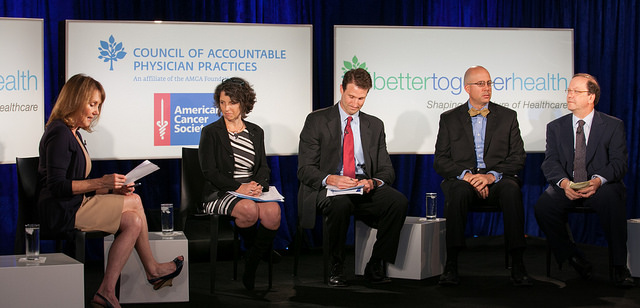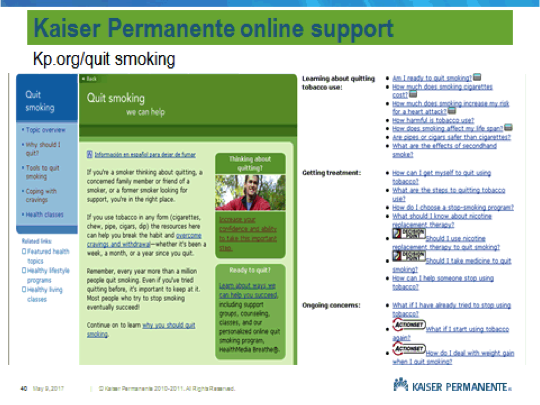It’s all you’ve ever wanted to know about the greening of health care! In our earlier post, we told you about the recent publication of the book, Greening Health Care, by Kaiser Permanente’s Kathy Gerwig. Today, we begin a series of excerpts from the book — and we start with an introduction and overview from the preface.
The very nature of health care is changing. Health care reform, clinical innovations, electronic medical records, social connectivity, technological advances, baby boomers’ expectations about quality of life, demands for price to align with value, and ways the environment contributes to disease are some of the factors behind the changes. These changes offer profound, new opportunities to address environmental issues across the health care sector and beyond.
In this changing landscape, what does environmentally sustainable health care look like? Let’s take an imaginary visit to a hospital for a routine doctor visit. Approaching the medical facility, the first thing we notice is that the building is smaller than we expected. There is a convenient transit stop at the front entrance. And the parking lot pavement allows rainwater to filter through to be cleaned and returned to the aquifer. We notice that instead of lawns there are native plantings that minimize water and pesticide use.
There is a garden path that takes us by a stream that was brought back to life from where it was hidden in a concrete culvert decades ago. We enjoy the birds that have rediscovered this tranquil place. You notice a labyrinth and take a meditative respite.
Once inside, we’re walking on nonvinyl, nonpolluting material on the carpets and floors, and we notice how much natural light floods into the lobby and hallways from specially designed window glass, shades, and blinds that allow sunlight in while minimizing afternoon heat. The walls are painted in soothing colors and patterns that mimic the adjoining landscape. The energy efficient lighting fixtures glow with a pleasing hue. You see a plaque on the wall indicating that the building is carbon-neutral.
In the bathroom, the toilets and sinks are water-conserving, and the soap does not contain harmful anti-bacterial agents. The paper towels are made from 100 percent recycled, post- consumer waste, and the used towels go into a compost container. In the waiting room, the fabric on the chairs was selected to avoid harmful chemicals that can cause adverse health effects.
In the exam room, your temperature and blood pressure are taken with mercury-free devices. You notice the purple exam gloves used by the clinical staff. These are latex-safe for worker and patient safety, and they are environmentally preferable.
If you are here for a biopsy, your doctor will use a rigid endoscope (for minimally invasive surgery) which is steam sterilized to avoid the use of chemicals that are hazardous to the environment and to staff. Patients’ X-rays are processed through a digital system that supports quality care by enhancing image analysis and transmission, and is environment-friendly because each machine eliminates the use of thousands of gallons of potable water annually as well as the chemicals and heavy metals needed for film processing.
As the housekeeping staff makes their routine rounds, we notice the absence of any chemical smells. That’s because they use products that clean without harmful chemicals. And you see a cleaning system that supports zero waste through recycling, remanufacturing, and composting.
When we stop for lunch in the cafeteria, we have a selection of healthy options that are delicious, locally sourced, and sustainably produced, just like most of the patient meals. When we pass by the vending machine, we see a selection of healthy, nonsugary snacks and drinks.
This feels to us like a place of emotional and physical healing. We are better able to handle the medical issue that brought us here. We appreciate the sense of total health that surrounds us.
Everything we see on our trip exists somewhere in the U.S. health care system today. In the future, we’ll see more of these features embedded in all care locations.
In my work as an environmental advocate in health care, I’m often asked how people can best contribute to a healthy environment. There is much we can and should do to lessen our impact on the environment, such as reducing reliance on fossil fuel, preferring products that do not contain harmful chemicals, and being mindful about consumption and waste. I believe, however, that the best thing we can do for the environment is to reduce our own health risks, or if we’re healthy to stay that way. The main causes of poor health in the U.S. are preventable: unhealthy eating, insufficient physical activity, tobacco use, and too much alcohol. One third of Americans are obese, and there is a tsunami of diabetics headed our way because millions of Americans are prediabetic today. Sedentary behavior increases the odds of cancer, stroke, depression, loss of bone density and a host of other illnesses. The resulting response from the health care system to diagnose and treat these illnesses is environmentally intensive.
Health is determined by many social and economic factors, including education, community safety, employment, and culture. It is determined by physical environments that include food, media, and environmental quality. And it depends on access to quality clinical care and prevention.
As individuals, we can work to reduce our own health risks by eating healthy foods, moving more, and finding our joy. As members of our local and global communities, we can promote policies, programs, and innovations that make healthy behaviors the easier behaviors.
The greening of health care is a lesson of hope. And the future of health care holds a promise of planetary healing that extends far beyond the system of health care.




